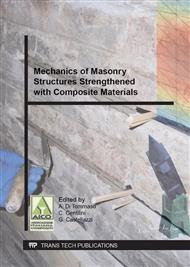p.486
p.494
p.502
p.510
p.518
p.526
p.534
p.542
p.551
Is it Possible to Repair Detached Composites Effectively after Failure of Masonry Strengthening
Abstract:
Strengthening of masonry structures using various externally bonded composite materials have been developed in the last decade. De-bonding of the FRP strengthening system from masonry, caused by an earthquake, has to be repaired quickly to protect the weakened structure against demolition during an aftershock. In this case the new rapid bonding methods, allowing for ductile behavior and reducing stress concentrations in the weakened masonry substrate, are missing. These rules fulfill highly deformable adhesives, made of flexible polyurethane polymers. In the paper, the results of Single Lap Shear Tests are presented, carried out on the specimens made of weak bricks strengthened using GFRP, BFRP, CFRP and SRP strips. They are compared with results obtained on the same specimens but repaired after failure using stiff epoxy adhesive and highly deformable polyurethane adhesive. Comparison of the obtained ultimate loads in damage tests and failure modes allowed determining efficiency of the tested repair methods.
Info:
Periodical:
Pages:
518-525
Citation:
Online since:
September 2014
Authors:
Keywords:
Price:
Сopyright:
© 2015 Trans Tech Publications Ltd. All Rights Reserved
Share:
Citation:


